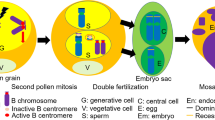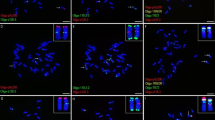Abstract
Rice (Oryza sativa L.) centromeres are composed of 155-bp satellite repeats (CentO), centromere-specific retrotransposon (CRR), and a variety of other repeats. Previous studies have shown that CentO and CRR elements are both parts of the functional centromere/kinetochore complex. In this study, a naturally occurring karyotype rearrangement involving a reciprocal translocation between chromosomes 9 and 11 in an indica rice Zhongxian 3037 has been identified. The recombinant centromere in Chr11L · 9L has two CentO tandem arrays, separated by a long array of 5S rDNAs. Chromatin immunoprecipitation and immunostaining showed that centromere-specific histone H3 (cenH3) variant was bound to the two flanking CentO arrays, but not to the 5S rDNAs residing between the CentO repeats. No obvious difference was detected in H3K4me2 and H3K9ac modification of the 5S rDNAs between the wild type and the mutant. Therefore, the translocation results in a recombinant stable chromosome with interrupted centromeric domains. A lack of cenH3 binding in 5S rDNA sequences residing within the centromeric core suggests that not all centromeric sequences confer centromere identity in rice.





Similar content being viewed by others

References
Alonso A, Fritz B, Hasson D, Abrusan G, Cheung F, Yoda K, Radlwimmer B, Ladurner AG, Warburton PE (2007) Co-localization of CENP-C and CENP-H to discontinuous domains of CENP-A chromatin at human neocentromeres. Genome Biol 8:R148
Bergmann JH, Rodriguez MG, Martins NM, Kimura H, Kelly DA, Masumoto H, Larionov V, Jansen LE, Earnshaw WC (2011) Epigenetic engineering shows H3K4me2 is required for HJURP targeting and CENP-A assembly on a synthetic human kinetochore. EMBO J 30:328–340
Black BE, Jansen LE, Maddox PS, Foltz DR, Desai AB, Shah JV, Cleveland DW (2007) Centromere identity maintained by nucleosomes assembled with histone H3 containing the CENP-A targeting domain. Mol Cell 25:309–322
Blower MD, Sullivan BA, Karpen GH (2002) Conserved organization of centromeric chromatin in flies and humans. Dev Cell 2:319–330
Cheng Z, Buell CR, Wing RA, Jiang J (2002a) Resolution of fluorescence in-situ hybridization mapping on rice mitotic prometaphase chromosomes, meiotic pachytene chromosomes and extended DNA fibers. Chromosom Res 10:379–387
Cheng Z, Dong F, Langdon T, Ouyang S, Buell CR, Gu M, Blattner FR, Jiang J (2002b) Functional rice centromeres are marked by a satellite repeat and a centromere-specific retrotransposon. Plant Cell 14:1691–1704
Earnshaw WC, Rothfield N (1985) Identification of a family of human centromere proteins using autoimmune sera from patients with scleroderma. Chromosoma 91:313–321
Fisher AM, Al-Gazali L, Pramathan T, Quaife R, Cockwell AE, Barber JC, Earnshaw WC, Axelman J, Migeon BR, Tyler-Smith C (1997) Centromeric inactivation in a dicentric human Y; 21 translocation chromosome. Chromosoma 106:199–206
Gong ZY, Wu HK, Cheng ZK, Gu MH (2002) Physical mapping of the 45S rDNA and 5S rDNA to rice prometaphase chromosome. Yi Chuan Xue Bao 29:241–244, Article in Chinese
Gong Z, Yu H, Huang J, Yi C, Gu M (2009) Unstable transmission of rice chromosomes without functional centromeric repeats in asexual propagation. Chromosom Res 17:863–872
Gong Z, Wu Y, Koblížková A, Torres GA, Wang K, Iovene M, Neumann P, Zhang W, Novák P, Buell CR, Macas J, Jiang J (2012) Repeatless and repeat-based centromeres in potato: implications for centromere evolution. Plant Cell 24:3559–3574
Haizel T, Lim YK, Leitch AR, Moore G (2005) Molecular analysis of holocentric centromeres of Luzula species. Cytogenet Genome Res 109:134–143
Han F, Gao Z, Birchler JA (2009) Reactivation of an inactive centromere reveals epigenetic and structural components for centromere specification in maize. Plant Cell 21:1929–1939
Han Y, Wang G, Liu Z, Liu J, Yue W, Song R, Zhang X, Jin W (2010) Divergence in centromere structure distinguishes related genomes in Coix lacryma-jobi and its wild relative. Chromosoma 119:89–98
Harrington JJ, Van Bokkelen G, Mays RW, Gustashaw K, Willard HF (1997) Formation of de novo centromeres and construction of first-generation human artificial microchromosomes. Nat Genet 15:345–355
Henikoff S, Ahmad K, Platero JS, van Steensel B (2000) Heterochromatic deposition of centromeric histone H3-like proteins. Proc Natl Acad Sci 97:716–721
Jin W, Melo JR, Nagaki K, Talbert PB, Henikoff S, Dawe RK, Jiang J (2004) Maize centromeres: organization and functional adaptation in the genetic background of oat. Plant Cell 16:571–581
Kamisugi Y, Nakayama S, Nakajima R, Ohtsubo H, Ohtsubo E, Fukui K (1994) Physical mapping of the 5S ribosomal RNA genes on rice chromosome 11. Mol Gen Genet 245:133–138
Layat E, Sáez-Vásquez J, Tourmente S (2012) Regulation of Pol I-transcribed 45S rDNA and Pol III-transcribed 5S rDNA in Arabidopsis. Plant Cell Physiol 53:267–276
Lee HR, Zhang WL, Langdon T, Jin W, Yan H, Cheng Z, Jiang J (2005) Chromatin immunoprecipitation cloning reveals rapid evolutionary patterns of centromeric DNA in Oryza species. Proc Natl Acad Sci 102:11793–11798
Lomiento M, Jiang Z, D'Addabbo P, Eichler EE, Rocchi M (2008) Evolutionary-new centromeres preferentially emerge within gene deserts. Genome Biol 9:R173
Malik HS, Henikoff S (2009) Major evolutionary transitions in centromere complexity. Cell 138:1067–1082
Nagaki K, Talbert PB, Zhong CX, Dawe RK, Henikoff S, Jiang J (2003) Chromatin immunoprecipitation reveals that the 180-bp satellite repeat is the key functional DNA element of Arabidopsis thaliana centromeres. Genetics 163:1221–1225
Nagaki K, Cheng Z, Ouyang S, Talbert PB, Kim M, Jones KM, Henikoff S, Buell CR, Jiang J (2004) Sequencing of a rice centromere uncovers active genes. Nat Genet 36:138–145
Nasuda S, Hudakova S, Schubert I, Houben A, Endo TR (2005) Stable barley chromosomes without centromeric repeats. Proc Natl Acad Sci 102:9842–9847
Neumann P, Navrátilová A, Schroeder-Reiter E, Koblížková A, Steinbauerová V, Chocholová E, Novák P, Wanner G, Macas J (2012) Stretching the rules: monocentric chromosomes with multiple centromere domains. PLoS Genet 8(6):e1002777
Page SL, Shin JC, Han JY, Choo KH, Shaffer LG (1996) Breakpoint diversity illustrates distinct mechanisms for Robertsonian translocation formation. Hum Mol Genet 5:1279–1288
Qi LL, Pumphrey MO, Friebe B, Zhang P, Qian C, Bowden RL, Rouse MN, Jin Y, Gill BS (2011) A novel Robertsonian translocation event leads to transfer of a stem rust resistance gene (Sr52) effective against race Ug99 from Dasypyrum villosum into bread wheat. Theor Appl Genet 123:159–167
Robertson WRB (1916) Chromosome studies. I. Taxonomic relationships shown in the chromosomes of Tettegidae and Acrididiae: V-shaped chromosomes and their significance in Acrididae, Locustidae and Grillidae: chromosomes and variations. J Morphol 27:179–331
Schubert I, Rieger FJ (1995) Alteration of basic chromosome number by fusion-fission cycles. Genome 38:1289–1292
Stoler S, Keith KC, Curnick KE, Fitzgerald-Hayes M (1995) A mutation in CSE4, an essential gene encoding a novel chromatin-associated protein in yeast, causes chromosome nondisjunction and cell cycle arrest at mitosis. Genes Dev 9:573–586
Sullivan BA, Willard HF (1998) Stable dicentric X chromosomes with two functional centromeres. Nat Genet 20:227–228
Talbert PB, Masuelli R, Tyagi AP, Comai L, Henikoff S (2002) Centromeric localization and adaptive evolution of an Arabidopsis histone H3 variant. Plant Cell 14:1053–1066
Tang XM, Bao WD, Zhang WL, Cheng ZK (2007) Identification of chromosomes from multiple rice genomes using a universal molecular cytogenetic marker system. J Integr Plant Biol 49:953–960
Topp CN, Okagaki RJ, Melo JR, Kynast RG, Phillips RL, Dawe RK (2009) Identification of a maize neocentromere in an oat-maize addition line. Cytogenet Genome Res 124:228–238
Wang G, Zhang X, Jin W (2009) An overview of plant centromeres. J Genet Genom 36:529–537
Wang G, He Q, Liu F, Cheng Z, Talbert PB, Jin W (2011) Characterization of CENH3 proteins and centromere-associated DNA sequences in diploid and allotetraploid Brassica species. Chromosoma 120:353–365
Wu Y, Kikuchi S, Yan H, Zhang W, Rosenbaum H, Iniguez AL, Jiang J (2011) Euchromatic subdomains in rice centromeres are associated with genes and transcription. Plant Cell 23:4054–4064
Yan H, Jin W, Nagaki K, Tian S, Ouyang S, Buell CR, Talbert PB, Henikoff S, Jiang J (2005) Transcription and histone modifications in the recombination-free region spanning a rice centromere. Plant Cell 17:3227–3238
Yan H, Talbert PB, Lee HR, Jett J, Henikoff S, Chen F, Jiang J (2008) Intergenic locations of rice centromeric chromatin. PLoS Biol 6:e286
Zhang P, Friebe B, Lukaszewski AJ, Gill BS (2001) The centromere structure in Robertsonian wheat-rye translocation chromosomes indicates that centric breakage-fusion can occur at different positions within the primary constriction. Chromosoma 110:335–344
Zhang W, Friebe B, Gill BS, Jiang J (2010) Centromere inactivation and epigenetic modifications of a plant chromosome with three functional centromeres. Chromosoma 119:553–563
Zhong CX, Marshall JB, Topp C, Mroczek R, Kato A, Nagaki K, Birchler JA, Jiang J, Dawe RK (2002) Centromeric retroelements and satellites interact with maize kinetochore protein CENH3. Plant Cell 14:2825–2836
Zhou J, Wang X, He K, Charron JB, Elling AA, Deng XW (2010) Genome-wide profiling of histone H3 lysine 9 acetylation and dimethylation in Arabidopsis reveals correlation between multiple histone marks and gene expression. Plant Mol Biol 72:585–595
Acknowledgments
We thank Prof. J. Jiang and Dr. H. Yan (University of Wisconsin–Madison) for their valuable comments. This study was supported by grants from the Natural Science Foundation of China (nos. 31171563, 31025018, and 31000538).
Author information
Authors and Affiliations
Corresponding authors
Electronic supplementary material
Below is the link to the electronic supplementary material.
ESM 1
(DOCX 13.8 kb)
Rights and permissions
About this article
Cite this article
Wang, G., Li, H., Cheng, Z. et al. A novel translocation event leads to a recombinant stable chromosome with interrupted centromeric domains in rice. Chromosoma 122, 295–303 (2013). https://doi.org/10.1007/s00412-013-0413-1
Received:
Revised:
Accepted:
Published:
Issue Date:
DOI: https://doi.org/10.1007/s00412-013-0413-1



